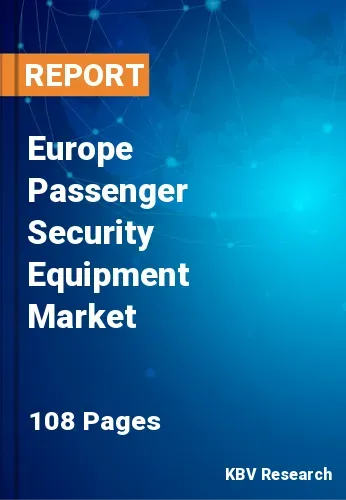The Europe Passenger Security Equipment Market would witness market growth of 8.1% CAGR during the forecast period (2022-2028).
The equipment and software not only assist the screener in detecting and recording illegal goods but also identifies and analyze their mistakes. The security control point (SCP) as a whole can be considered a complicated socio-technical system. Its effectiveness is determined by a variety of factors, including the type of x-ray devices used, the type of SCP structure utilized, and the equipment's technical condition, but it is mostly determined by the efficiency of the security screeners' job. The sorts of faults and their frequency are given special attention. Look at the quantitative links between different sorts of errors and the frequency with which virtual danger pictures are projected (TIP). This technology is a form of intelligent support system that also checks the work of the screener. The research was based on measurements taken at the Katowice-Pyrzowice International Airport in real-world situations.
It's a major task to keep public spaces like airports safe. At airports, Transportation Security Administration (TSA) security personnel look for dangerous goods such as weapons, chemicals, and liquids that are not permitted as carry-on items. Metal detectors, millimetre wave machines, backscatter x-ray, and cabinet x-ray machines are among the screening tools they employ. These gadgets are also capable of detecting items that are hidden. Each of the several types of screening equipment utilised at airports nowadays serves a particular screening purpose. To keep safe, guidelines for utilising the equipment have been established.
The United Kingdom is and always has been one of the world's most well-connected countries. The number of locations served by UK airports and available seat capacity are both higher than in any similar European country. Heathrow continues to handle the most international visitors of any airport on the planet. Governments, have a personal accountability to plan for the future, especially when it comes to long-term infrastructure like as runways, which take years to plan and build. To do so, officials must analyse a variety of future scenarios as well as their consequences for the type and amount of infrastructure that would be required.
Aerospace is a top priority for the German government. Aerospace is an important industry in Germany, according to the Federal Ministry of Economic Affairs and Energy (BMWi), with high growth rates and a solid industrial core.
The Germany market dominated the Europe Passenger Security Equipment Market by Country in 2021, and would continue to be a dominant market till 2028; thereby, achieving a market value of $6,669 million by 2028. The UK market is experiencing a CAGR of 7.2% during (2022 - 2028). Additionally, The France market would exhibit a CAGR of 8.9% during (2022 - 2028).
Based on Offering, the market is segmented into Equipment and Services. Based on Transport Infrastructure, the market is segmented into Airport, Train Stations, Bus Stations, and Seaports. Based on Type, the market is segmented into Fire Safety & Detection System, Explosive Detection System, Intrusion Detection & Prevention System, Baggage Inspection System, People Screening Systems, Video Surveillance, and Others. Based on countries, the market is segmented into Germany, UK, France, Russia, Spain, Italy, and Rest of Europe.
Free Valuable Insights: The Global Passenger Security Equipment Market will Hit $105.9 Billion by 2028, at a CAGR of 8.6%
The market research report covers the analysis of key stake holders of the market. Key companies profiled in the report include Siemens AG, L3Harris Technologies, Inc., Smiths Group PLC, Autoclear LLC, Kapsch TrafficCom AG, Honeywell International, Inc., Axis Communications AB, Bosch Security Systems GmbH, Rapiscan Systems, Inc., and SITA.
By Offering
By Transport Infrastructure
By Type
By Country

Our team of dedicated experts can provide you with attractive expansion opportunities for your business.

